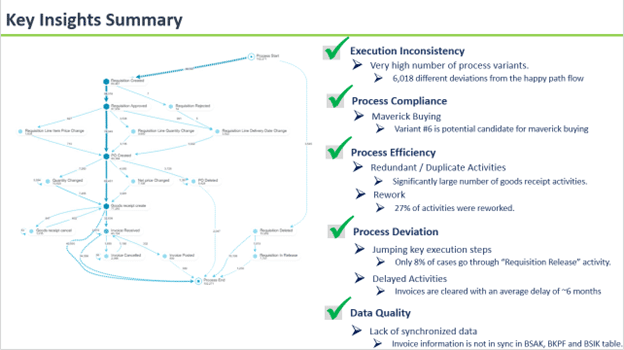Process Mining Uncovers Hidden Inefficiencies for Chemical Distributor
September 23, 2022
Our Client
Our client is a leading producer and distributer (LPD) of chemical fertilizer products for the agricultural industry. Prolifics has provided LPD test automation services for years; this story represents the first expansion of our offerings to them related to process mining and automation.
Challenge
LPD had become aware of process mining as a way to uncover inefficiencies for potential automation in different areas, and we engaged with LPD to run a pilot program to demonstrate opportunities and benefits.
Process mining uses a company’s own data to find a better way of doing things. Customers, vendors, and the workforce generate data – “digital footprints” – any time they use company systems. Process mining follows this digital trail and automatically creates a map of the process – visualizing and diagraming the actual flow, including variations, exceptions, gaps and siloes.
Action
Prolifics’ Arup Datta is a Senior Consultant and line-of-business Lead for our business process management (BPM) practice. “We did an initial workshop with LPD to help them select a candidate scenario or candidate use case, or what you might say, a candidate process. In the workshop we asked them a bunch of questions; we spoke with their business segments and together we selected these three processes within procure to pay: requisition, purchase order, and vendor invoice.
“We helped them prepare and gather the input data necessary for the process mining analysis. After performing the analysis, we came up with business-level dashboards, analysis reports, different types of analytics and some recommendations for the three processes.”
Salem Hadim is Prolifics’ Head of Digital Solution and Cloud Solutions Consulting Segment. “With the first set of process mining data, we were able to narrow things down and find potential improvement opportunities, areas that we really wanted to explore and find those sweet spots for automation. We were able to show opportunities well beyond what we wanted to prove in the pilot.”
The business-level dashboard Prolifics provided information on any kind of inconsistency the three LPD processes: inefficiencies and any type of compliance, execution, or data quality issues. It looked for any type of deviation from what Hadim and Datta call “the happy path” – the way the processes were meant to work.
Results
Through the process mining exercise, Hadim, Datta and their Prolifics team found about 6,000 different deviations in LPD’s happy path flow. “This kind of analysis was a sticker shock to them,” said Datta. “Their business users said, ‘We had no idea about this.’ Execution inconsistency was one big thing.”
For example, Prolifics found multiple different redundant and duplicate activities – 27 percent of the tasks were rework. Datta explains, “When we spoke initially with the business users, they said, ‘Well, everything is happy path. I do this task. He does that task.’ But when we actually looked into the data, it’s like one group does a task, then another does the same task. Let’s say I perform a task. I closed it. It’s finished. Then, I come back to it after a week, I have to do this again, and then maybe this alarm comes back to it. Someone else has to do this again, and so on.”

What process mining provides you is that it lets your C-level people know what’s going right and what’s going wrong. It gives them the tool and the view of what is happening on the ground with their processes. Now, the next step after process mining is telling the client where and how we can help them – and that usually means automation.
Download Case Study ;Resource Center
Using Prolifics’ Process Mining, Leading Chemical Distributor Uncovers Hidden Inefficiencies
Download this case study for more details on:
How Prolifics helped our client prepare and gather data for a process mining analysis.
The process undertaken to implement a business-level dashboard that informs 3 key business processes.
Improvement opportunities uncovered by Prolifics’ process mining solution.